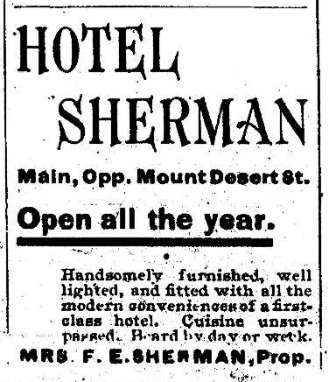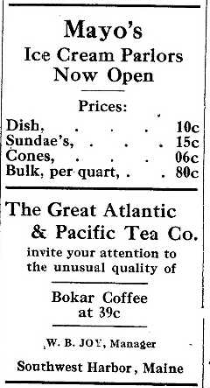YOUNG CHILD NEARLY DROWNS
September 20, 1899
Bar Harbor Record
A young child, the four year old son of a man who is in the employ of Nick Curran at the Curran House, Eagle Lake, had a remarkablely narrow escape from meeting death by drowning on Thursday. The lad with his little brother, aged 20 months, was playing on the wharf when he fell into the water. The baby brother ran to the house, a distance of possibly 100 yards, and catching his mother by the dress said; "Brother, water."
The mother looked from the door, saw her son in the water, quickly summoned help and the lad who had, in the meantime, been blown half way across the cove, was soon icked up by a boat. When rescued the boy was purple all over and apparently dead, but Mr. Curran has cared for many drowning people, and applied remedies which had somewhat revived the patient before the arrival of Dr. E.J. Morrison who soon had the lad out of all danger. Dr. Morrison made a record of his trip out to Eagle lake which has probably never been equalled, doing a distance, a good three miles over a hilly road, in nine and one half minutes from his office.
 |
| EAGLE LAKE - ACADIA NATIONAL PARK |
September 22, 1897
Bar Harbor Record
NOT LOST AT ALL
Mr. Waldron Bates returned to Boston Monday night. Sunday Mr. Bates accompanied by Mr. Chambers, who cuts out the mountain paths blazed by Mr. Bates, trampled from Jordon's Pond over Sargent Mountain and through the Eagle Lake trails, a distance of about 15 miles. Darkness fell long before they emerged at the Curran House and their friends became worried as one could scarcely see a foot ahead of him in the open. Mr. Bates familiarity with the paths and trails brought him out safely however about 7 o'clock that evening. Several connecting paths were laid out Sunday which will, when opened, render mountain climbing on the island more delightful.
NEWS FROM CURRAN HOUSE
FISHING AT EAGLE LAKE
June 7, 1888
During the week ending June 2nd, 140 fish were taken in Eagle Lake and 126 in Bubble Pond. Ed Clark, L.W. Chatto and A.J. Grant took seven large salmon in two hours. Frank Young and friends took twenty-one salmon in four hours. Mr. Higgins, proprietor of the Eagle Lake House, has captured a large number of fine fish off his wharf. N.C. Curran, the veteran sportsman, claims to be the first to take the salmon on Eagle lake with the fly. June 1st, with a nine ounce Leonard rod, he captured seven salmon weighing 12 1/2 pounds. Miss Jessie Young took four large fish the same day. Mr. Curran says it requires a good rod to take these salmon, as they are much more gamy than trout. The brown hackle, silver doctor or red iris are the best flies to use.
SACRED CONCERT
September 20, 1888
A party of railroad men had a sacred concert, Sunday, in the grove adjoining the Curran House, Eagle Lake. There about were twenty in the company. Landlord Curran gave them a good spread under the trees, and they passed the day very enjoyably.
November 10, 1892
Bar Harbor Record
GRANITE MINING
Mr. N.F. Curran at his quarry near Eagle Lake is getting out some splendid stone and is having large orders for it. He can get out some fine building stone and can quarry it twenty feet long and five feet deep. It is an exceedingly pretty granite and has proved very satisfactory to all who have used it.
NICK CURRAN DEAD
October 16, 1901
Bar Harbor Record
The death of Nicholas F. Curran, which occurred at the hospital on Monday, removes a unique character from our midst, - a man whom there was none to love and very few to praise. He lived a singular, nomadic sort of life preferring a camp to a home. It is told that it was not always thus, but that he went into the woods in his younger days to seek health and finding there more enjoyment than in civilization, he left his home and wife for the freedom of the hunter and camper. He certainly made camp life pleasant, as any one who has visited him at Eagle Lake can testify.
That underneath his rough exterior he hid some noble qualities as shown by the manner with which he treated those placed under his care when his services have been engaged to nurse patients afflicted with contagious diseases. In the diphtheria epidemic that visited our town some years ago it was "Nick" Curran that was called upon to care for the sick ones everywhere. Absolutely without fear he went thither and yon whenever sent for, and there are many who owe their lives to his kind ministrations.
Not the least of the many evidences of the blessing of the Bar Harbor Hospital, is the knowledge that here in his last days Nick Curran was given the same good care that he has in so many instances shown to others. Services were held yesterday morning at the Episcopa Church and he was taken to Bangor, his former home for burial accompanied by Mrs. Curran who came to attend the services.
THE YOUNG CASE
Nick Curran Offers Help
December 18, 1895
Bar Harbor Record
On last Tuesday afternoon, representatives of the board of health and the selectmen went down to the shanty occupied by John Young and what was left of his family after the scourge of typhold fever, and set fire to it. The little place and all its contents quickly disappeared in smoke, and the broken hearted owner stood sadly by, a silent looker on, and watched the smoke curling upward and leaving behind nothing but a pile of ashes - all that was left of his home. For the first time in his life he was homeless; for the little rough shanty with its painful memories of the past few months was once a cheerful place for him, his wife and their family of six children, and when he returned from his fishing trip, he always had a welcome greeting there. When he saw the men applying the match to his little house, he said not a word and made no objection to the carrying out of the order of the board of health. On the contrary, Mr. Young appeared to breathe a sigh of relief when the tongues of flame licked up the last bit of timber and the tottering sides fell into the room where he had suffered such pain and sorrow and from which he had borne out to the grave his wife and two children. When it was all over he turned sadly away and went to the house of Deacen Thomas, a friend who with his wife had shown during the illness what a true friend was. Mr. Young is now making his home with the Thomas family.
Before the match was applied to the house, Messrs Clark and Paine asked Young to set a value on the place and the contents, but he offered no figure. The value of the place and its contents is placed by the men who examined them at about $150. The town will reimburse the owner as far as it is possible to do by a payment of money. Young has improved in health since he got a chance to sleep and rest, and Sunday called on Dr. Douglass at Bar Harbor. It was said that he will soon come into a small inheritance by the death of a relative who lived in Seal Harbor.
The four children who were brought here are doing nicely. One of them, a boy ten years old, is in the Pest House at the "Witch Hole," and is being cared for by Nicholass Curran, who volunteered to nurse him back to health. The child was at the home of Mrs. Ann Higgins, and a few days ago was taken sick. Dr. Douglass thinks that the child is not in a dangerous condition, and today is reported to be out of danger. None of the other children are ill.
The fund started by the Record for the relief of John Young and his children was given its first contribution a few hours after the Record left the press, and from the way in which the money comes pouring in from each mail, a handsome sum will be realized which will be placed to the best advantage for the benefit of the family. Accompanying many of the contributions are letters of sympathy for the unfortunate family.
The contributions to the Young Fund up to date;
Mrs. Harriet S. Jaques, Boston, $25.00
William Lawrence Green, Albany, N.Y. - $10.00
Clifford Brigham, Salem Mass., $10.00
Hollow Of His Hand Mission, Bar Harbor, $10.25
J. Milton Allen, Bar Harbor - $5.00
Mary E. Leeds, Boston, $5.00
Mrs. S. Shaw, Boston, $5.00
Parke Goodwin, New York, $5.00
C.E. Lindall, Bar Harbor, $2.00
Capt. Sawtelle, Bar Harbor, $2.00
E.S.J. Morse, Bar Harbor, $1.00
A.E. Farnsworth, Southwest Harbor, $1.00
Mrs. A.E. Farnsworth, Southwest Harbor, $1.00
F.C. Lynam, Bar Harbor, $1.00
LEGAL NOTICE
Mary Curran
April 7, 1897
Bar Harbor Record
On this date a Legal Notice was placed in the paper stating that Mary Curran was seeking damages for loss of property as a result of the Bar Harbor Water Company building a dam on Eagle Lake, which resulted in the rise of the water level of the lake, which resulted in her lossing a good size section of land. It states that because neither Mary Curran nor the Bar Harbor Water Company could not come to an agreement as to what her damages was, a judge was being asked to step in and come up with an amount which she should be paid. The land in question was the site of Curran House, the property left to her by the death of her hsband, Nick Curran.
Below is a second Legal Notice which appeared right below the above the top notice, but much easier to read so I am posting it in two parts as it appeared in the paper;

































